Kibyra Ancient City is built on three hills with lake and plain views, within the borders of Gölhisar district of Burdur . Known as the ‘City of Gladiators’, the city is located 110 km southwest of Burdur city centre. It is built at an altitude of 1,100-1,300 meters, covered with juniper and cedar forests, at a point overlooking the western slope of the Gölhisar Plain.
Strabo of Amasya, who mentioned Kibyra, which had its brightest days in the Lydian and Roman periods, in his notes, stated that the people of Kibyra were originally Lydians. With the excavations started in 2006 in the city, which has a history of 2,300 years, gigantic monumental structures with a magnificent view were brought to their feet.
The city, which has a deep-rooted state tradition and bureaucracy, has become the judicial center of 25 cities around it. They bred fast-running horses, showed their mastery in wood carving, leatherwork, ceramics and ironwork, and became famous for their military strength. They established the world’s largest parliament building in the city identified with gladiators.
The Upper and Lower Agora, one of the most magnificent stadiums in Anatolia, the Parliament Building and the Theater, with their ancient structures that do not block each other, are located at a point overlooking the endless plain. Although it takes a lot of time to reach the 2,300-year-old ancient city from Burdur and Isparta, it is a heritage worth visiting.
Kibyra Ancient City, Burdur
Kibyra Ancient City is located within the borders of Gölhisar district of Burdur. Kibyra, which was one of the most important military garrison cities of these civilizations during the period when the Lydian and Roman Empires dominated the lands of Western Anatolia, is located on a point overlooking the western slope of the Gölhisar Plain, covered with juniper and cedar trees, at an altitude of 1,100 to 1,300 meters.
In the records of the famous traveler Strabo from Amasya, the Kibyrans are originally mentioned as Lydians. According to Strabo, the Kibyrans migrated from Lydia and came to the Kabalis region. In a very short time, they took control of the region and took the Pisidians and other peoples living in the geography under their yoke.
Before long, they changed the residential areas and turned the area into a planned living center. It is reported that they established a city with a circumference of 100 Stadia. In the same source, it is emphasized that four different languages are spoken in Kibyra, namely Lydian, Solyme, Pisid and Hellenic.
Kibyra, II. During the reign of Eumenes (197-159 BC), they came under the rule of the Kingdom of Pergamon. In the following period, 2 BC and 1 BC They established the Kabalis Region Four Cities Union, consisting of the ancient cities Boubon, Balboura and Oinoanda located in Kibyra and its close vicinity.
Kibyra had two votes, while the other three cities had one vote, as it was able to deploy 30,000 infantry and 2,000 mounted cavalry to the Kabalis Region Four Cities Union army, which was formed by the four joint councils. The city has always been ruled by tyrants.
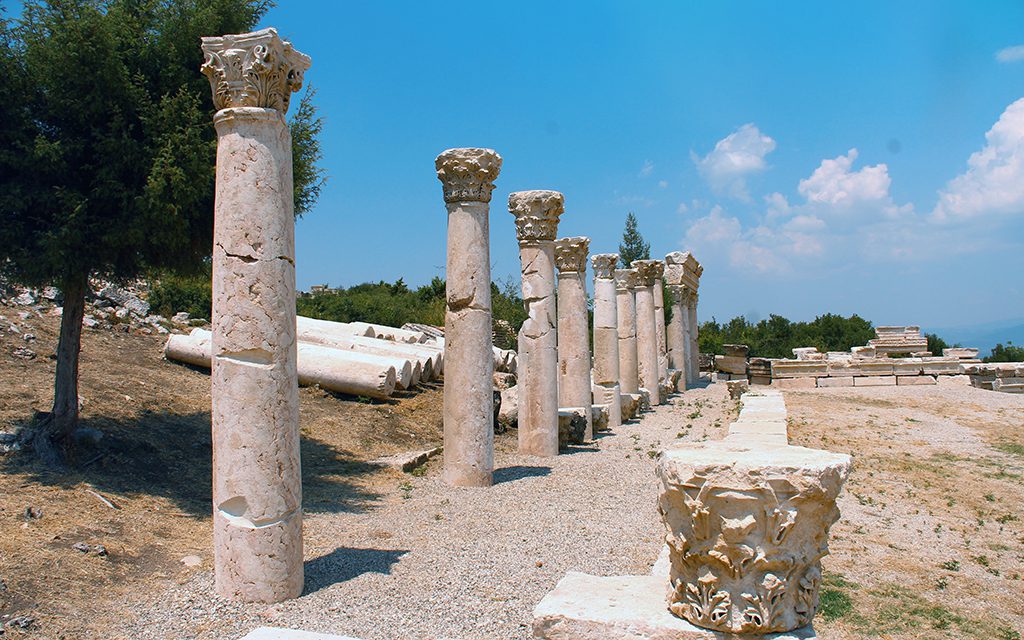
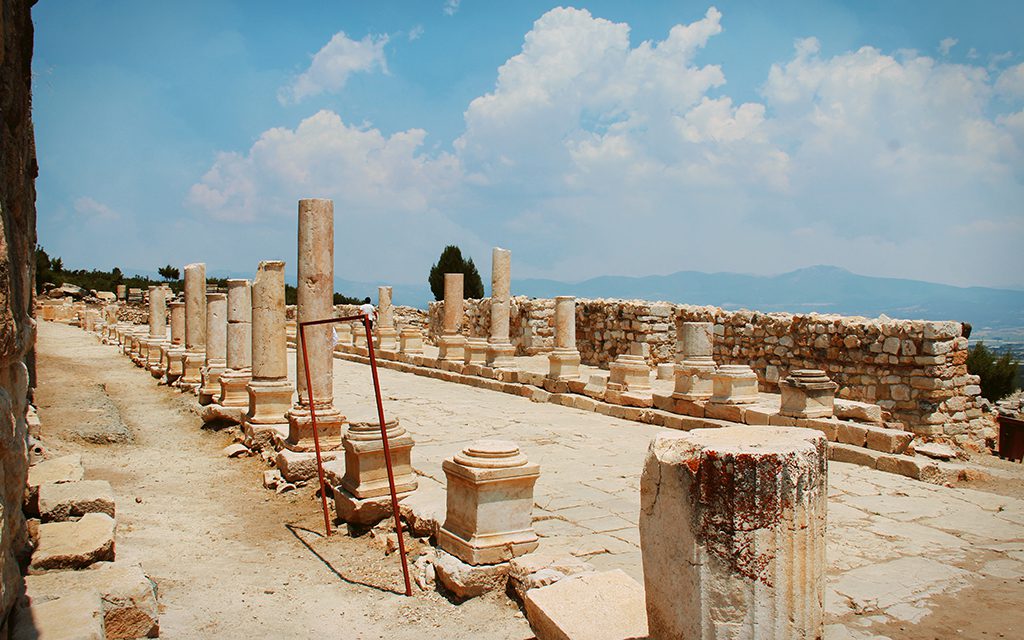
The Roman general Murena dissolved the 40-year-long union, ending the reign of Moagetes II, the tyrant of Kibyra, in 82 BC. Bubon and Balbura were included in the Lycian League, while Kibyra was included in the Roman Empire’s Asia Minor Province.
Although Strabo, who tells the story of Kibyra, does not mention the other city of Oineanda, which formed the union, it is estimated that this city was connected to Lycia like the others.
The Roman Emperor Tiberius of the time brought tax amnesty for 5 years and provided financial aid to the city, which was mostly destroyed by an earthquake in 23 AD. The people of Kibyran, who did not give the emperor’s support unconditionally, showed their gratitude by changing the name of the city to Caesarea Kibyra (Emperor’s Kibyra).
Kibyra had its heyday especially in the 1st and 3rd centuries AD. The city, which also functions as the judicial center of 25 cities in the region with its strategic geographical location, was famous for horse breeding in ancient times. Because of this feature, the city was also referred to as ‘the city of fast-running horses’.
Excavations continue at full speed on three hills with magnificent views of the lake and plain where the ancient city was founded. The majority of the structures that have survived to the present day belong to the Roman period. The works for the inclusion of the ancient city, which was included in the UNESCO World Heritage Tentative List in 2016, on the permanent list are also ongoing.
Kibyra Ancient City Places To Visit
Kibyra, a 12 thousand-seat stadium reflecting the Roman and Byzantine architectural tradition, a four-functional music house (odeon) covered with Medusa mosaic in the orchestra section, which is unique in the world, late Roman bath, agoras, main street, 9 thousand-person capacity theater, winter theater and underground. It is worth seeing with its tombs.
Monuments and sarcophagi are lined up on both sides of the main street at the eastern entrance of the city. During the excavations, the longest gladiator friezes of antiquity in Turkey were found here. Gladiator reliefs of more than 30 thousand infantry and over 2,000 mounted soldiers on display at the Burdur Museum highlight the militaristic character of the city.
1. Stadium
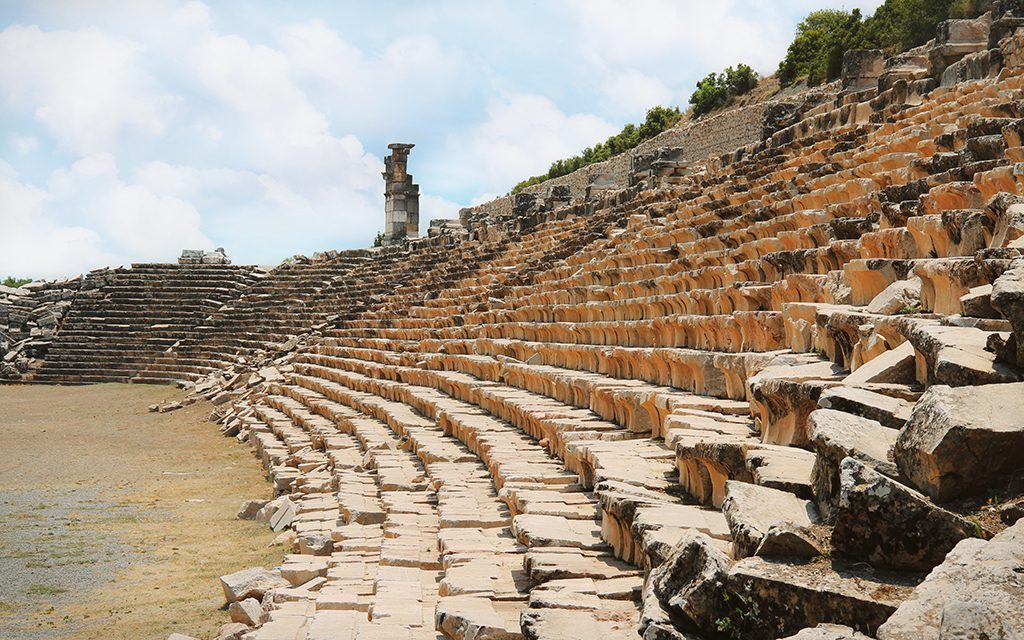
The stadium is located on the left at the entrance of the ancient city of Kibyra. With a capacity of 12 thousand people and a runway length of 200 meters, the structure was used for sports purposes in the first period of its construction. In the later period, gladiatorial battles were held in the stadium.
It is shown among the five most magnificent stadiums of the ancient period. Stadion is entered through a monumental door. Another door is the vaulted door in the middle of the south apse.
Since the western side of the stadium rests on the high bedrock of the slope, 21 sitting steps were made here, while 7 sitting steps could be placed on the point with a low slope opposite. Thus, the magnificent plain and lake view of the audience sitting opposite was not blocked.
Under the western rows of seats, they set up a large storage container, Pithoi, which was connected to the pipes, preventing future rain water from reaching the stadium floor.
2. now
It can be reached from the east-west oriented Main Street connecting the Agora of Kibyra, the Theater and the Stadium. The street is connected to the Agora columnar street extending in the north direction and the street extending to the theater in the west by an intersection. Covered columned galleries extend over three terraces. Close to the northwest corner of the Agora, there is the Roman Period bath structure and the Gymnasion on the plain in front of it.
3. Bathroom
The bath has a history of at least 1,800 years in the ancient city of Kibyra. The main structure of the bath, which is estimated to have been built during the Roman period, is 2,600 square meters, and its total area reaches 5,400 square meters.
The hammam, the third largest building in the city after the stadium and the odeon, is one of the largest in Anatolia. The heating system, on the other hand, is designed to heat the marbles under the marbles on the floor.
4. Theater

Kibyra Antique Theater is one of the most magnificent structures of the city with a capacity of 9 thousand. It is identical to many medium-sized ancient theaters in Anatolia. The seating arrangement, where the equal dominance of the stage from each point is ensured due to the vertical seating areas, reflects the architectural difference of the city from other cities.
The charitable works of the prominent people of the city for the city are engraved as Hellenic on the walkway blocks that divide the rows of seats horizontally. The seats of the theater and the ornate entrance gate to the south have been excavated.
5. Odeion
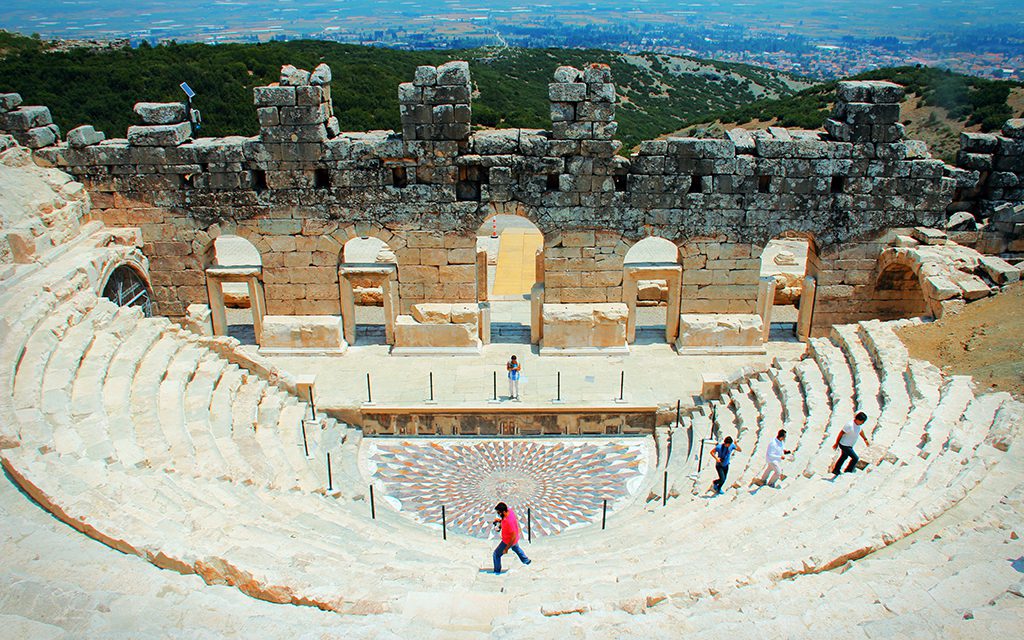
Odeion is another building that puts the ancient city of Kibyra on the list of the best in the world. It is located in the southwest of the hill where the public buildings of the ancient city are located. It is the largest ancient period public structure that can be covered with a roof and heated in ancient Anatolia.
The Odeion, called the Music House/Assembly Building, has a capacity of approximately 3600 people with 31 rows of seats. The Kibyra Odeon, which is the largest odeon in the world with its known dimensions, was used as the courthouse where large cases were held, since it was the judicial center of the Province of Asia Minor in the Roman Period.
While the administrative center in the Anatolian geography, which is called the Province of Asia Minor of Rome, was in the city of Ephesus, the judicial center was located in Kibyra. Kibyra, where the head of the court is located, has undertaken the task of the judicial center of 25 cities around it.
It is thought that the Odeion, with the stage building added in front of it, was used as a theater, where the city council meetings were held at the same time during the winter months. A total of 540 square meters of mosaic flooring was unearthed in the front area of the theater. It is the largest fully intact mosaic ever found in Anatolia.
It is thought to have fallen into disuse, most likely after a fire in the 4th century. It was unearthed in an almost completely preserved state, except for its roof, which seems to have collapsed as a result of fire. Medusa, made of colored marble, unearthed in the very center of the orchestra, is fascinating with its depiction.
6. Medusa Mosaic
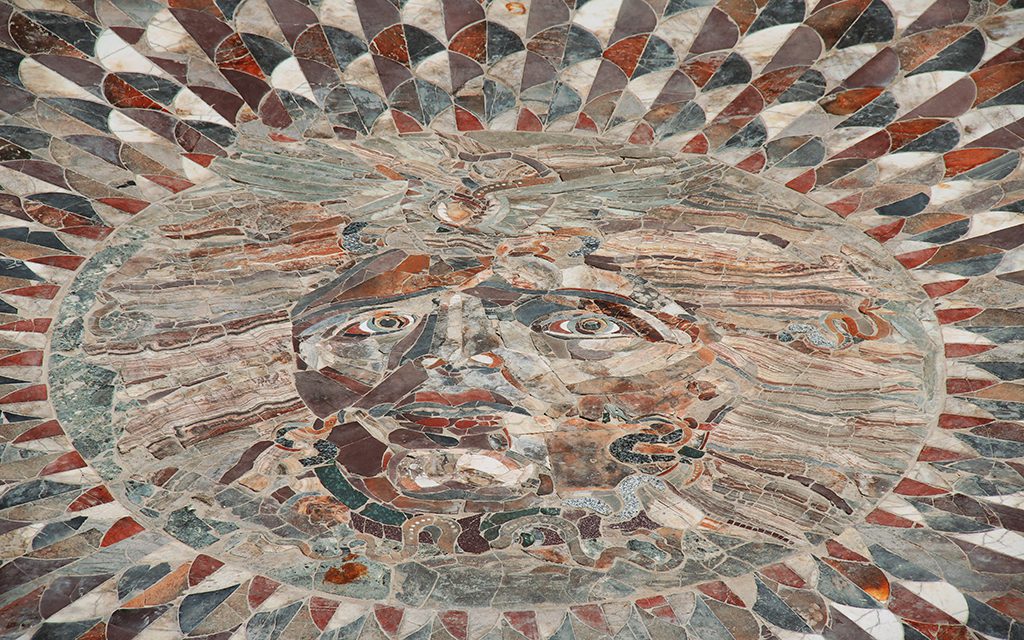
The Medusa Mosaic is a marvel of art built in the first period of the 1st century AD. The mosaic depicting Medusa, known as a snake-haired, sharp-toothed, female monster believed to turn malicious people into stone in mythology, is unique. It is made of red and white marble with the ‘Opus Sectile’ technique.
Such a Medusa painting that adorns the middle of the orchestra floor of the Kibyra Odeon is like no other in Anatolia. She is captivating with her huge eyes, her tongue hanging out between her thick lips, her wavy hair and snakes entwined around her neck, and the leaf-like marble decorations surrounding her.
All of the archaeological finds unearthed in the Kibyra excavations are preserved and exhibited in the Burdur Museum today. Burdur Museum, located in the city center of Burdur, received the “Museum Worth Visiting” Award in 2008. There are more than 60 thousand cultural assets in the museum, which contains the finds of the ancient city of Sagalassos.
Kibyra Ancient City entrance fee and visit information
Kibyra Ancient City is located within the borders of Horzum Neighborhood, in the Gölhisar district of Burdur. The ancient city, which can be easily reached from many big cities by private vehicle, is 110 km from Burdur, 142 km from Antalya , 332 km from İzmir , 531 km from Ankara and 688 km from Istanbul.
You can easily reach the ancient city of Kibyra by coming to Gölhisar by following the Çavdır-Denizli road route through Antalya. From the Ankara side, it is possible to reach Gölhisar by following the Gölhisar-Fethiye direction from the Afyonkarahisar-Burdur highway.
You can reach Kibyra Ancient City by following the Acıpayam-Gölhisar line from the İzmir-Aydın-Denizli route. While you are in Kibyra, you can add the Böğrüdelik plateau, Gölhisar lake, Kocagöl, Yusufça Early Byzantine church to the list of places to see.
Burdur’s Gölhisar district, which has made a name for itself with its lavender scented village, is also famous for its roasted and black cumin coffee. If you have the opportunity, search, find and listen to the ‘Teke Region’ music from Sipsi masters.
Kibyra Ancient City is a magnificent ancient city that has been eagerly awaited at every moment of the excavations in the archaeological world in recent years. The city, which was one of the centers where gladiators and horsemen were trained during the Roman Empire, is worth seeing with its architectural structures that have survived to the present day.

















